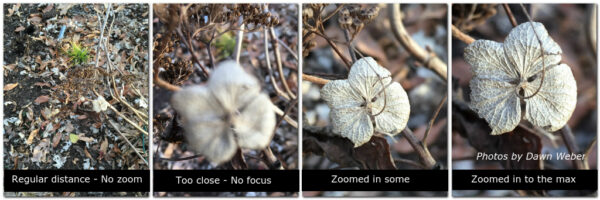By Dawn Weber
Today’s tip is for smartphone users:
Sometimes close is too close
I’ve had occasions where I wanted to get a quick photo of a small flower or an insect and the results are blurry because the camera won’t focus on the intended subject.
That undesirable result could be for many reasons, but a primary one is that I was too close to the subject of the photo. Camera lenses have a minimum focus distance, the distance between the lens and the subject. For my iPhone 6s, as an example, it is 3.5 inches. If I’m closer than that, the camera is unable to focus, and my photo won’t turn out as I would like.
I can still get that close-up photo by moving the lens slightly away from the subject (back to at least that 3.5-inch distance) and using the smartphone camera’s zoom functionality to “get closer”. On most mobile phones, this action is a pinch-and-expand the screen type of move. Adjusting in this way allows me to maintain the minimum distance needed but hopefully capture more of the detail.
If I don’t want to venture outside and practice on winter seed heads, I can use small detailed objects around the house – a penny, pen, pencil, or any object that has some writing on it, or even the newspaper. Items with words or distinct lines help to demonstrate the change in clarity between the photos.
Be sure to take a few photos too close (intentionally out of focus) and then some with the camera moved away from the subject and zoomed in so that you can see the difference. Practice makes progress!
This post was the first in a photography series
Many of us wander around our gardens and snap quick photos to share with others, to send away for identifications, or maybe to show off a cool insect that we found. Unfortunately, the results can be disappointing, blurry, too dark, or too light. Don’t dismay, help is on the way!
This photography series will give you tips to build your camera skills for taking photos of native plants and all of the visitors that come with them. The aim is to post a few tips for each type of camera: smartphone, point-and-shoot, and DSLRs. Winter is a great time to practice some new techniques so that when those spring wildflowers start to bloom, you will be ready to go!
Editor’s Note: Member Dawn Weber’s photo of wild bergamot (Monarda fistulosa) guttation, titled “Under Pressure” won “People’s Choice” for the Wild Ones 2015 photo contest.



